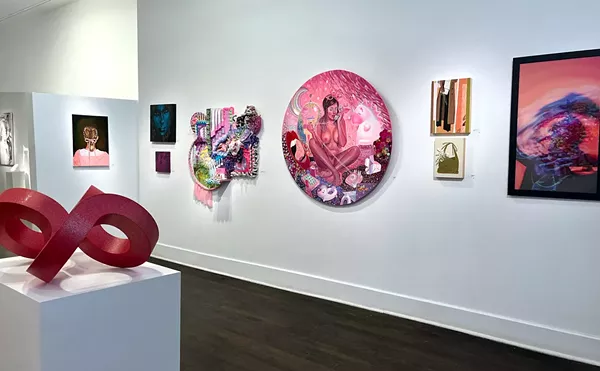
Audio By Carbonatix
[
{
"name": "GPT - Leaderboard - Inline - Content",
"component": "35519556",
"insertPoint": "5th",
"startingPoint": "3",
"requiredCountToDisplay": "3",
"maxInsertions": 100,
"adList": [
{
"adPreset": "LeaderboardInline"
}
]
}
]
Working at Play: A History of Vacations in the United States
by Cindy S. Aron
Oxford University Press, $35, 324 pp.
Staging Tourism: Bodies on Display from
Waikiki to Sea World
by Jane C. Desmond
University of Chicago Press, $30, 384 pp.
On Holiday: A History of Vacationing
by Orvar Löfgren
University of California Press, $29.95, 320 pp.
Dreamland: America at the Dawn of the Twentieth Century
by Michael Lesy
New Press, $40, 207 pp.
Why are books written by professors so boring, even when they don’t have to be? OK, so it’s not like I’m the first person to ask this question. But that doesn’t mean it isn’t still worth asking.
Take this one for example, Working at Play: A History of Vacations in the United States, by Cindy S. Aron. The reason I’m asking is that the subject of Aron’s book really is interesting: Vacations, and how Americans had to be taught how to take them.
It’s not as if the middle class sprang full-blown from the brain of Martha Stewart or Betty Crocker. We had to learn how to be the people we aspired to become. And one of the important ways of learning this was by taking vacations.
Aron recounts the social history of planned idleness, starting right after the Civil War, and extending up to about 1950. It’s an interesting story, or at least it could have been. Aron’s book is full of information – period newspaper accounts, journal and diary entries, letters, all kinds of potentially interesting sources – and for those not sleep-challenged, that information is readily available, since she is a clear – if uninspired – writer. The book is straightforward and neatly organized, by period and also type of vacation: Resorts, self-improving vacations, tourism, camping, etc. She even includes a few (too few) illustrations.
Aron’s general thesis is that vacations were largely pedagogical, but also troubling because time off from work struck most people as unnatural, maybe even dangerous.
"Vacationing generated fear and anxiety among the nineteenth-century middle class," she writes, "because vacationers were people at leisure and leisure remained problematic." We were afraid to be alone with ourselves, with nothing to do.
The real story, then, is about America’s conflicted puritan soul, and how we conquered our dread of idleness, through the collaboration of health experts and religious leaders, along with businessmen, journalists and an evolving technology, all of which were required to make modern vacationing possible as something people thought they could, in fact should do, like drinking the daily glass of red wine – not for pleasure’s sake (of course), but for their health.
Unfortunately, that same guilty contest between rectitude and delinquency has played itself out with Aron herself – just like the pleasure-dreading vacationers she’s writing about. A dry and professorial treatment, apparently, is the only way to dignify the ephemera of popular culture. But this ephemera is the stuff most people usually think of as "real" life; it’s the stuff that makes us who we are.
Take bathing suits, for example, and the kinds of cultural deal-making that had to go on to allow for the public display of female bodies. A self-serious attitude is just the way not to see how complex a thing the elements of play can be. It would be interesting to know what the suits looked like, inside and out. How they were advertised and sold, how they were worn. Even when Aron has primary sources at hand, she seems unwilling to let much of the material in, or to ask interesting questions about it.
Not that Aron’s the only one taking off on a little cultural studies trip; academics are really getting into vacations nowadays. There’s Jane C. Desmond’s Staging Tourism, for instance; or On Holiday: A History of Vacationing, by Orvar Löfgren, professor of ethnology at the University of Lund, Sweden. His scope is wider than Aron’s, since he takes in the whole of Western culture, and he’s more fun – too much fun, in fact. His hooky-playing light touch turns occasionally into a self-mocking kind of goofing, as if he too lacks the courage to take fun seriously, on its own terms.
Which gets back to the question I started with. What is it about professors that makes them – us, since I’m one too – so preternaturally inept at having a good time?
The news, fortunately, isn’t all bad. There’s the case of Michael Lesy, for example. Also a professor, Lesy can tell a good story, and has, most famously in Wisconsin Death Trip, and more recently in Dreamland: America at the Dawn of the Twentieth Century.
That book documents beautifully many of the leisure sites where Americans were learning, a hundred years ago, how to be ourselves. And we were being taught by the postcard photographs (created by the Detroit Photographic Company) that provide Lesy’s gorgeous illustrations.
We learned how to be ourselves by becoming the people in the pictures, taking a trip, visiting a city, idling the afternoon away on Belle Isle. Levy’s aim, explained in a lyrical and brief introduction, is to make visible a lost world that he discovered when he first encountered the Detroit Photographic materials at the Library of Congress: "all the wonders and contradictions of the early twentieth century are arrayed in miniature, image after image, beating past the eyes like the strokes of a metronome."
He notes the selectivity and idealization (by omission) undertaken by Detroit Photographic, which did not care to represent the "toxins" of modern life.
Lesy is not writing an exposé, however. His concern, finally, is with the power of this vanished world – this "dreamland" – to manifest itself in its photographic self-representations: "Living in the now, we look at the then, and, for a milli-second, before we can resume disbelief, we experience that vanished world as if it were as present as our rods and cones."
That’s a kind of vacation too – wandering those lost sights, with Americans who were just then learning how to be themselves, the selves we’ve now become. And what’s best, much of that record is available on the Web.
This is what scholarship ought to be about: The pleasure of looking at things most people don’t look at, either because they don’t know where to look, or how. But pleasure ought to be the goal, like on a good vacation. Provided, of course, you know how to take a vacation, and not everybody does.





